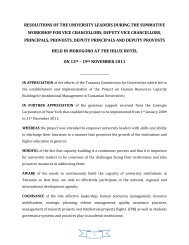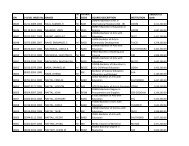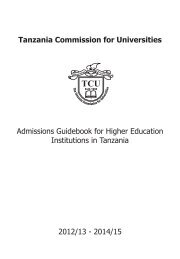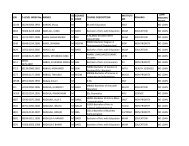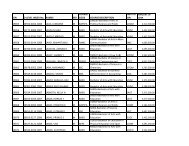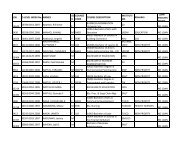Handbook for Quality Assurance in Higher Education The ... - TCU
Handbook for Quality Assurance in Higher Education The ... - TCU
Handbook for Quality Assurance in Higher Education The ... - TCU
Create successful ePaper yourself
Turn your PDF publications into a flip-book with our unique Google optimized e-Paper software.
For assess<strong>in</strong>g our quality, we need a yardstick or benchmark. An absolute yardstick, ready<br />
<strong>for</strong> use does not exist. This means we have to look <strong>for</strong> criteria and standards that can be<br />
used. In some cases, the criteria and standards are <strong>for</strong>mulated by one of the stakeholders.<br />
Governments often have <strong>for</strong>mulated criteria and standards <strong>in</strong> the framework of accreditation.<br />
In other cases, employers or the profession have <strong>for</strong>mulated standards. When there are no<br />
pre-<strong>for</strong>mulated requirements, it is up to the university to decide upon the standards, tak<strong>in</strong>g<br />
<strong>in</strong>to account <strong>in</strong>ternational developments (benchmark<strong>in</strong>g).<br />
In many cases, the externally <strong>for</strong>mulated so-called standards are often more criteria than<br />
standard. A criterion can be seen as a specific aspect, decisive <strong>for</strong> the quality. For example,<br />
the criterion can be: “the university has a clearly <strong>for</strong>mulated mission and vision”. Or “the<br />
computer facilities must be adequate”. A standard gives the level that a criterion must meet.<br />
Sometimes, a government or an accredit<strong>in</strong>g body can give a clear quantitative figure, e.g. the<br />
number of computers per student must be X. In most cases, the level of the criterion will be<br />
described as must be adequate, but what adequate is, is not <strong>for</strong>mulated. In the case of selfassessment<br />
by a university, the university has to f<strong>in</strong>d out what adequate means. This can be<br />
done by a university carry<strong>in</strong>g out a comparison between itself and others that are <strong>in</strong> the same<br />
situation (e.g. benchmark<strong>in</strong>g). In the case of accreditation or external quality assessment, it is<br />
left to the group of experts to decide if someth<strong>in</strong>g is adequate or not.<br />
<strong>The</strong> quest <strong>for</strong> quality is not an easy one, especially s<strong>in</strong>ce there is no absolute quality or objective<br />
quality. Nevertheless, we expect higher education to assure its quality, to demonstrate<br />
its quality and to have its quality assessed by outsiders. And this is happen<strong>in</strong>g all over the<br />
world. <strong>The</strong> National Council <strong>for</strong> <strong>Higher</strong> <strong>Education</strong> of Uganda, the Tanzania Commission <strong>for</strong><br />
Universities and the Commission <strong>for</strong> <strong>Higher</strong> <strong>Education</strong> of Kenya have <strong>for</strong>mulated criteria and<br />
standards, <strong>for</strong> an <strong>in</strong>stitution, as well as <strong>for</strong> the core activities of the <strong>in</strong>stitution: Teach<strong>in</strong>g/learn<strong>in</strong>g,<br />
research and community outreach. Compar<strong>in</strong>g the documents from the three agencies,<br />
we see that those standards and criteria have a lot <strong>in</strong> common, and are also look<strong>in</strong>g around<br />
<strong>in</strong> the world we see that they are <strong>in</strong> l<strong>in</strong>e with what is go<strong>in</strong>g on <strong>in</strong> other countries. Everyone is<br />
look<strong>in</strong>g at more or less the same aspects <strong>for</strong> assess<strong>in</strong>g quality. In the United States, Europe,<br />
South America, Africa, Asia or Australia, the quality experts and universities are look<strong>in</strong>g at<br />
more or less the same aspects, also called criteria and standards. Sometimes the word<strong>in</strong>g of<br />
the standards and criteria is different, but <strong>in</strong> most cases they cover the same aspects. Look<strong>in</strong>g<br />
at the <strong>in</strong><strong>for</strong>mation that all three regulatory bodies are requir<strong>in</strong>g from the <strong>in</strong>stitutions when<br />
apply<strong>in</strong>g <strong>for</strong> accreditation, one may distil the criteria that are seen as important, as shown <strong>in</strong><br />
Table 1. <strong>The</strong> table gives a comparison of the requirements <strong>in</strong> Kenya, Tanzania and Uganda.<br />
Guidel<strong>in</strong>es <strong>for</strong> Self Assessment<br />
7<br />
IUCEA/ CHE/ NCHE/ <strong>TCU</strong>/ DAAD



